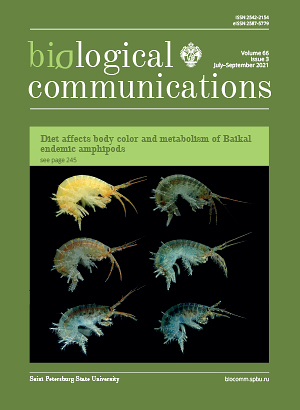Transcriptomic analysis of sym28 and sym29 supernodulating mutants of pea (Pisum sativum L.) under complex inoculation with beneficial microorganisms
DOI:
https://doi.org/10.21638/spbu03.2021.301Abstract
The garden pea (Pisum sativum L.), like most members of Fabaceae family, is capable of forming symbioses with beneficial soil microorganisms such as nodule bacteria (rhizobia), arbuscular mycorrhizal (AM) fungi and plant growth promoting bacteria (PGPB). The autoregulation of nodulation (AON) system is known to play an important role in controlling both the number of nodules and the level of root colonization by AM via root-to-shoot signaling mediated by CLAVATA/ESR-related (CLE) peptides and their receptors. In the pea, mutations in genes Sym28 (CLV2-like) and Sym29 (CLV1-like), which encode receptors for CLE peptides, lead to the supernodulation phenotype, i.e., excessive nodule formation. The aim of the present study was to analyze the response of pea cv. ‘Frisson’ (wild type) and mutants P64 (sym28) and P88 (sym29) to complex inoculation with rhizobia, AM fungi and PGPB, with regard to biomass accumulation, yield and transcriptomic alterations. The plants were grown in quartz sand for 2 and 4 weeks after inoculation with either rhizobia (Rh) or complex inoculation with Rh + AM, Rh + PGPB, and Rh+AM+PGPB, and the biomass and yield were assessed. Transcriptome sequencing of whole shoots and roots was performed using a modified RNAseq protocol named MACE (Massive Analysis of cDNA Ends). In the experimental conditions, P88 (sym29) plants demonstrated the best biomass accumulation and yield, as compared to the wild type and P64 (sym28) plants, whereas P64 (sym28) had the lowest rate of biomass and seed yield. The transcriptome analysis showed that both supernodulating mutants more actively responded to biotic and abiotic factors than the wild-type plants and demonstrated increased expression of genes characteristic to late stages of nodule development. The roots of P64 (sym28) plants responded to AM+Rh treatment with upregulation of genes encoding plastid proteins, which can be connected with the activation of carotenoid biosynthesis (namely, the non-mevalonate pathway that takes place in root plastids). The more active response to symbionts in P88 (sym29) plants, as compared to cv. ‘Frisson’, was associated with counterregulation of transcripts involved in chloroplast functioning and development in leaves, which accompanies successful plant development in symbiotic conditions. Finally, the effect of retardation of plant aging upon mycorrhization on a transcriptomic level was recorded for cv. ‘Frisson’ but not for P64 (sym28) and P88 (sym29) mutants, which points towards its possible connection with the AON system. The results of this work link the plant’s autoregulation with the responsiveness to inoculation with beneficial soil microorganisms.
Keywords:
RNAseq, transcriptomics, arbuscular mycorrhiza, nodule bacteria, complex inoculation, autoregulation of nodulation, garden pea
Downloads
References
Downloads
Additional Files
Published
How to Cite
License
Articles of Biological Communications are open access distributed under the terms of the License Agreement with Saint Petersburg State University, which permits to the authors unrestricted distribution and self-archiving free of charge.





